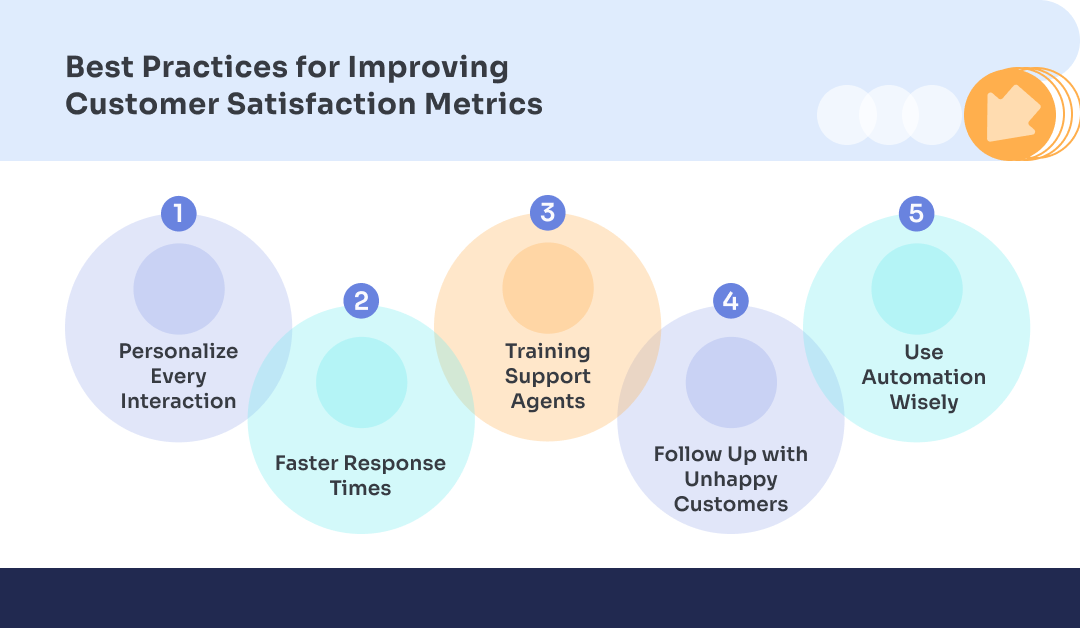Modern businesses are closely tied to their customers, but at the heart of it lies the question: Are your customers really satisfied with what you have to offer? Indeed, the ultimate goal of any business is to achieve maximum customer satisfaction, and if you are not aware of whether they are satisfied or not, you are missing out on key insights that could mean the difference between success and failure. That’s where customer satisfaction metrics come in.
Customer satisfaction metrics aren’t just numbers; they tell you how happy your customers are with your service, product, and overall experience. Keeping a close eye on the right metrics of customer satisfaction helps you enhance support quality, retain customers for the long term, and ultimately build a loyal customer base.
In this article, we’ll explore what the most important metrics are, how to track them effectively, and how to leverage the data you collect. We’ll also discuss how outsourcing support can help you monitor this metric and improve customer satisfaction continuously.
ScaleSupport helps businesses live up to customer expectations without losing sight of what really matters: happy customers.
Why Customer Satisfaction Metrics Matter
Customer satisfaction metrics provide a way to assess where you stand with respect to your customers and whether they are getting value out of it as promised. It provides a broader picture of how your customers feel about your company and what’s working (or not) in your support and product experience.
These insights, in turn, help CX teams identify their areas of strength as well as where they need to grow to improve business performance. When you know which customers are dissatisfied and why, you can move on to take action as necessary to keep them.
Alternatively, skipping this key metric can deprive you of valuable feedback, and before you know it, you may end up losing customers without knowing why.
A PwC study found that 32% or 1 in 3 customers will leave a brand they love after just one bad experience. This simple fact reinforces why it pays to be proactive about. Above all, satisfied customers are your biggest advocates and marketers who can pave the way for further referrals and more customers.
When you have the right measurement systems in place, you don’t just react but act on real data to resolve potential issues before they turn into customer service challenges. This eventually fosters trust at every stage of the customer journey.
Which Customer Satisfaction Metrics Should You Track?
There are no one-size-fits-all customer satisfaction metrics as far as customer satisfaction is concerned. Businesses can track different customer support KPIs to be precise, but which of these can prove most beneficial for your business? Here is an overview of the most important customer satisfaction metrics you should focus on ;
CSAT or Customer Satisfaction Score
CSAT is a metric that measures whether your CX team delivers exactly what customers expect in terms of customer service. A survey or email questionnaire can be used to collect your CSAT score by asking customers to rate their satisfaction levels on a scale of 1 to 5, with 1 denoting the lowest end of satisfaction and 5 the highest. Including open-ended questions in the survey can prompt customers to elaborate on their recent interactions.
Here are 6 smart tips on how to calculate CSAT effectively to get the most accurate insights.
CSR or Customer retention rate
While adding new customers to your business is vital to expand your business, you would be amiss if you couldn’t hold on to your existing customers. As per a Harvard Business Report, a 5% increase in retention rates can push your profits up by between 25 to a whopping 95%.
CSR is the rate at which you retain customers over a period of time. If I have clients who keep coming back to you over time, this can be taken as a reliable indicator that they trust you for your services and are eager to depend on you.
First Contact Resolution
This metric measures your ability to resolve a customer’s query or request in the very first interaction. Suppose that a customer reaches out to you for a billing error, and your customer support agent fixes it right away in the course of the call.
Since the query is resolved in the initial contact, the customer wouldn’t need to call you again with the same issue. A higher FCR points to the effectiveness of your support mechanisms, while a low FCR emphasizes the need for better training, tools, or processes.
CES
This metric asks customers how easy it was to operate a product or use a service on their own. A high CES means that they have to put in more effort to get an issue resolved or a request filled. CES surveys are generally used to obtain this metric, which requires customers to rate the ease of their experience on a scale of 1 to 5, where 1 is very difficult and 5 is very easy.
The score is usually taken to be the average of the entire sum of your customer interactions in general, and not a specific one. For instance, if you receive 100 responses and the average of these scores is 4.4, this suggests that most customers find it easy to interact with your product or service.
Average Response Time
Customers expect quick answers to their queries. Average response time, also known as average resolution time, refers to the time it takes to respond to and resolve support tickets. The more delayed your responses, the lower the satisfaction, even if the ticket eventually gets resolved.
When monitoring this metric, observe trends both across various customer issue types and among individual agents. This may lead you to the root cause behind the delay – the nature of the problem at hand or the slow pace of your agents.
NPS ( Net Promoter Score)
NPS is a customer service metric that is a simple yet effective way to measure customer satisfaction and loyalty. You can get your NPS score by conducting an NPS survey, where customers will be asked to rate on a scale of 10 how likely they are to recommend your business to others. NPS rankings can be divided into three distinct categories:
- Promoters – those who rate from 9-10.
- Passives – those who rate either 7 or 8
- Detractors – those who answer 6 or below
Out of these respondents, promoters are most satisfied and thus likely to refer you, while detractors are least likely to do so.
How to Measure Customer Satisfaction the Right Way
It’s not just what you measure; it’s how you measure that determines the accuracy of the output. If you intend to get meaningful results, you need the right tools, timing, and strategy.
Use Multiple Feedback Channels
There are multiple channels available to collect feedback, each of which provides a different lens into the customer experience. Email surveys are one such channel that allows you to communicate with your customers and encourage them to share their feedback anonymously.
Businesses can also utilize in-app feedback at different interaction points or chat ratings during or following chats to understand customer sentiments. When customers are genuinely happy with your services, they are all the more eager to respond to your call and register their opinions honestly.
Ask the Right Questions
Surveys are a major source of customer experience metrics, but their efficacy depends on asking the right questions. The questions should be short and to the point without resorting to misleading or complex language. The questions can be related to a specific scenario or outcome to tap into how your customers feel about your product or customer journey.
The timing counts too; the most effective questions are the ones that immediately follow an experience for CSAT. You can wait a few days for broader questions like NPS.
Use Tools That Integrate with Your Workflow
You can embed surveys using Platforms like Zendesk, Intercom, or HubSpot and capture data in real time. This would allow you to track trends, all while staying connected within your existing support ecosystem.
Make Your Metrics Actionable
Data on its own is nothing but numbers. Its true value lies in extracting key insights so that it can drive results for you.
Look for Patterns
- Customer satisfaction metrics can reveal underlying patterns in your customer service strategy. For example, it can tell you which agents or teams are getting better scores or what products are bringing more complaints.
- You can also identify which regions are constantly achieving high scores compared to others.
Segment Your Data
- In light of this data, you can then segment the data based on certain common themes or concerns. For example, one segment of data can deal with new customers vs. long-term ones, while another can separate high-value clients from casual users.
Close the Loop
- Once you have got your answers, you can proceed to the practical side of things. For instance, you can reach out to customers who rated you low to find out their pain points and thus tailor your offerings accordingly.
- You can share feedback with the team to maximize your strengths or factors that contribute to retention, as well as work to overcome the limitations.
Customer feedback analysis is a powerful tool to unlock the true potential of these metrics and use them as guides in improving customer satisfaction and loyalty. Learn here why a Customer Success Manager Is Crucial for Business Growth.
Best Practices for Improving Customer Satisfaction Metrics

Tracking the right customer satisfaction metrics that fit your business needs and goals is the first step. The second and most important step is to improve your processes and the quality of your customer experience. Here are five practical, proven ways to move the needle in the right direction.
1. Personalize Every Interaction
Customers want to feel seen as if they have an identity of their own. The acquired customer data can be used to personalize the customer’s purchase journey to their preferences and liking. Calling them by their name, recalling past issues, and tailoring support to their history are all ways to introduce a personal touch to the interactions. A little personalization goes a long way toward making customers feel valued and significantly enhancing the perception of the brand.
2. Faster Response Times
Slow response times are the foremost complaint of customers, which leaves them disgruntled. The less time an agent takes to respond to a request or ticket, the more satisfied customers will be. Customers appreciate a quick response, as long wait times can frustrate and even compel them to consider an alternative service. To achieve faster response times, it’s necessary to streamline your processes as well as back up agents when ticket volumes are too high.
3. Training Support Agents
Invest in training agents to empower them to handle conversations with more confidence and empathy. Providing ongoing coaching to agents not only improves their communication skills but also adds to their product knowledge, which has a positive impact on your scores.
4. Follow Up with Unhappy Customers
Customers who leave a low score or negative reviews demand special attention. A proper follow-up mechanism should be devised to reach out to such customers to discover what complaints they have and what needs and expectations they associate with your brands.
Closing the loop indicates that you care about customer input and are willing to rectify it. This can increase the prospects of turning a detractor into a potential promoter of your brand.
5. Use Automation Wisely
Repetitive day-to-day tasks can take up much time and energy from your support teams. Integrating automated feedback can free up your team to tackle high-value clients or complex cases. Automation should work to supplement human support and not replace it, as only humans can offer empathy that makes interactions truly rewarding.
Improving customer satisfaction metrics is an ongoing process of smoothing hurdles along the way to making the customer journey convenient, efficient, and result-oriented.
Effects of Outsourcing on Customer Satisfaction Metrics
Outsourced customer support has emerged as a viable alternative to managing on-site, but it is not without concerns over losing control or quality.
This is what discourages many business owners from handing over support functions because they feel it can risk being disconnected or impersonal. However, when done right, outsourcing can make a visible difference to the customer experience, which will eventually reflect in your customer satisfaction metrics. Here’s why;
- Specialized support teams are trained to resolve issues swiftly and empathetically.
- Our 24/7 availability ensures faster response times, directly boosting customer satisfaction and loyalty.
- Scalable coverage, guaranteeing consistent service even during peak periods like product launches or holidays.
- Built-in reporting allows you to track key metrics such as CSAT, NPS, and FCR in real-time.
ScaleSupport strives to become an extension of your brand by seamlessly integrating with your support systems. We handle the complexity of customer interactions with utmost professionalism while staying true to your tone and brand vision to help you consistently exceed customer expectations.
This isn’t about taking a back seat but a smart-savvy way to turn customer support into a competitive advantage while boosting your satisfaction metrics.
The Path Forward: Start Measuring What Matters
Today’s business landscape is more competitive than ever before, where every customer matters. This means that excellent support is no longer an option but a key market differentiator. By keeping tabs on and leveraging your most important customer satisfaction metrics, you gain visibility into all aspects of your customer service journey.
This can eventually help you upgrade your customer service operations and frustrated customers into loyal advocates for sustainable customer success.
If you’re planning to scale your support operations strategically, the right support partner is crucial. Explore ScaleSupport’s services to learn how we can help you build world-class support systems that customers love to interact with.
Ready to elevate your customer experience? Schedule a free consultation to discuss your specific customer support needs. Start your journey today and let the results speak for themselves.

Dianne has extensive experience as a Content Writer, she creates engaging content that captivates readers and ranks well online. She stays on top of industry trends to keep her work fresh and impactful. She has a talent for turning complex ideas into relatable stories. When she’s not writing, you’ll probably find her with a crochet hook in hand or working on a fun craft project. She loves bringing creativity to life, whether it’s through words or handmade creations.






